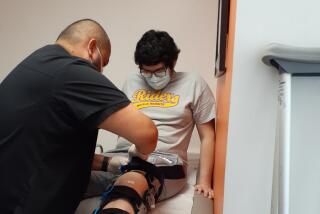Making Progress by Staying Put : Stationary trainers let riders on any schedule hone their pedaling and sprinting techniques.
- Share via
While bicyclists in much of the country are chased indoors for the winter months, Southern California enjoys a year-round cycling climate.
Long-legged Lycra tights and a simple wind shell cut out the chill. Shorter days can be accommodated with an adjustment in schedule: before work or at lunch instead of evening. Rain, especially in these years of drought, is too infrequent to cause concern.
That doesn’t mean, however, that local riders can’t benefit from indoor training. As a supplement to a regular road riding schedule, riding indoors can have several benefits for competitive cyclists and serious recreational riders.
There is one required investment: a stationary trainer. These devices clamp the rear wheel of the bicycle and provide riding resistance with an adjustable roller. There are several types, ranging in price from about $100 up to several hundred dollars.
Dennis Ferguson, a triathlete who owns an Irvine sports shop and sponsors a series of duathlons (combined running and riding events), uses a stationary trainer extensively in his workout schedule. It is especially useful for interval training, which can build speed, and for polishing pedal technique, Ferguson said.
Interval training, in which brief, intense rides (at 90% to 95% of maximum heart rate) are interspersed with short breaks, can be difficult on the road, where the rider must contend with traffic and other distractions.
“You can focus in and concentrate on a quality workout” with a stationary trainer, Ferguson explained. “On the road, you really couldn’t do it.” Even on bicycle-only paths, such as the Santa Ana River Trail, riders must contend with other cyclists and the dips beneath bridges.
On the stationary trainer, the workout can be tightly regulated, which makes it easier to maintain consistency--the same workout can be repeated without variation. Some riders wear monitors to keep a running tab on their heart rate, allowing them to keep it within the prescribed range.
(Determining “maximum heart rate,” to undertake a program of strenuous exercise, should be done with the help of a physician.)
A steady warm-up of about 15 minutes will get the legs ready. Riding intervals may last from one to four minutes, with one- to two-minutes rests between each interval. One of Ferguson’s workouts, for instance, consists of a series of four-minute intervals, with two-minute rests.
Stationary trainers are also ideal for sprint training--bursts of 15 to 30 seconds, followed by longer rests. Again, the concentration required for sprint training is difficult to maintain on the road. Sprints and interval training help by raising what is called a rider’s “anaerobic” threshold--the ability to accelerate to near-maximum levels for short bursts, a necessary talent in race situations.
Sprint training also helps riders practice a smooth stroke at high r.p.m. Ferguson has another technique for practicing his “spinning” on the stationary trainer: He puts one leg up on a chair and pedals with the other. Pedal pressure should be constant throughout the cycle (the main reason clip-on pedals are popular); pedaling with one leg will isolate any hitches in technique.
“If you have an up-and-down pedal stroke, it really accentuates that,” Ferguson said.
Ferguson’s average workout on the stationary trainer is an hour, although some people will sit on the bike for up to two hours. Sometimes Ferguson will break up his workout with one-mile runs, to simulate the switch needed to race in triathlons. “It gets the legs used to coming off the bike and running,” he said. “You can be pretty creative about your workouts.”
Stationary trainers can also prove a substitute for regular road rides, “for the 9-to-5 type people” who can’t get a ride in during the daylight hours, Ferguson said.
“It’s a very time-efficient tool,” Ferguson said. “You ride for an hour on a trainer, there’s no stopping, no turning, no coasting.” And, for those on a tight training schedule, it does come in handy on those rare rainy days.
Irvine triathlete Andy Carlson cautioned against relying too heavily on stationary trainers, however, especially for those who compete in races.
At one time, he was using the stationary trainer five days a week, but found that he was losing his road-handling skills.
“You learn a lot riding on the road, dodging potholes,” said Carlson, who races professionally. “When you use (a stationary trainer) too much, and you get out there in a race situation, you realize your handling is just not there.”
He says it is a useful supplemental tool, however, and he continues to use it once or twice a week.
Two weeks ago, this column profiled an indoor roller hockey program in Orange. A representative from the Saddleback Valley Unified School District called to let us know about an outdoor program in Mission Viejo that started last summer and already has 350 kids, 6 to 17 years old, competing on 24 teams.
The district is preparing to launch adult tournaments on its two rinks also. For information, call (714) 768-0981.


